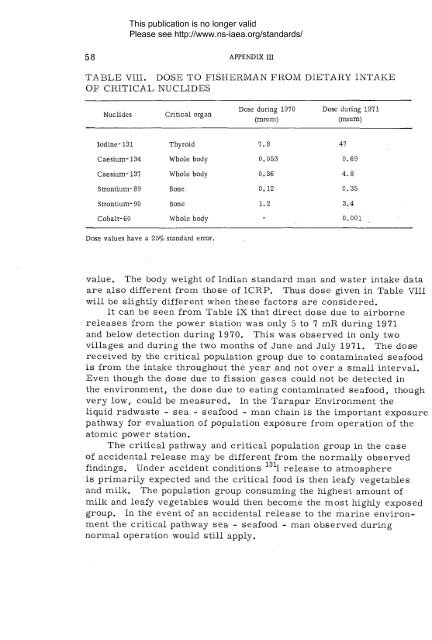Safety_Series_041_1975 - gnssn - International Atomic Energy ...
Safety_Series_041_1975 - gnssn - International Atomic Energy ...
Safety_Series_041_1975 - gnssn - International Atomic Energy ...
Create successful ePaper yourself
Turn your PDF publications into a flip-book with our unique Google optimized e-Paper software.
This publication is no longer valid<br />
Please see http://www.ns-iaea.org/standards/<br />
5 8 A PPENDIX III<br />
TABLE VIII. DOSE TO FISHERMAN FROM DIETARY INTAKE<br />
OF CRITICAL NUCLIDES<br />
N uclides<br />
C ritic a l organ<br />
Dose during 1970<br />
(m rem )<br />
Dose during 1971<br />
(m rem )<br />
Io d in e -131 Thyroid 7 . 8 47<br />
C a e siu m -134 W hole body 0 .0 5 3 0 .6 9<br />
C a e siu m -137 W hole body 0 .3 6 4 . 8<br />
S tro n tiu m -89 Bone 0 .1 2 0 .3 5<br />
Strontium - 90 Bone 1 .2 3 .4<br />
C o b a lt-60 W hole body - 0 .0 0 1<br />
Dose values have a 25% standard error.<br />
value. The body weight of Indian standard man and water intake data<br />
are also different from those of ICRP. Thus dose given in Table VIII<br />
will be slightly different when these factors are considered.<br />
It can be seen from Table IX that direct dose due to airborne<br />
releases from the power station was only 5 to 7 mR during 1971<br />
and below detection during 1970. This was observed in only two<br />
villages and during the two months of June and July 1971. The dose<br />
received by the critical population group due to contaminated seafood<br />
is from the intake throughout the year and not over a small interval.<br />
Even though the dose due to fission gases could not be detected in<br />
the environment, the dose due to eating contaminated seafood, though<br />
very low, could be measured. In the Tarapur Environment the<br />
liquid radwaste - sea - seafood - man chain is the important exposure<br />
pathway for evaluation of population exposure from operation of the<br />
atomic power station.<br />
The critical pathway and critical population group in the case<br />
of accidental release may be different from the normally observed<br />
findings. Under accident conditions 131I release to atmosphere<br />
is prim arily expected and the critical food is then leafy vegetables<br />
and milk. The population group consuming the highest amount of<br />
milk and leafy vegetables would then become the m ost highly exposed<br />
group. In the event of an accidental release to the marine environment<br />
the critical pathway sea - seafood - man observed during<br />
normal operation would still apply.

















